Physical Address
304 North Cardinal St.
Dorchester Center, MA 02124
Aneuploidy refers to an abnormal number of chromosomes that is not an exact multiple of the haploid number of chromosomes for the species (23 in humans). Humans normally have a diploid karyotype, with two complete chromosome sets, for a total of 46 chromosomes. Most aneuploid fetuses have either a single extra chromosome (trisomy) or a single missing chromosome (monosomy). The term aneuploidy is occasionally more broadly used to refer to any abnormality in chromosome number, which also includes an abnormal number of chromosome sets (e.g., a complete extra set, as in triploidy). This chapter focuses on evaluation of abnormalities of chromosome number commonly identified on antenatal ultrasound, including trisomy 21, trisomy 18, trisomy 13, monosomy X (Turner syndrome), and triploidy.
First-trimester screening provides early identification of pregnancies at increased risk of aneuploidy, facilitating timely diagnosis with additional testing such as chorionic villus sampling ( ![]() and
and ![]() ). Patients have more time to weigh their options if an abnormality is discovered. If termination of pregnancy is desired, the procedure can be performed in the earlier stages of pregnancy, when it is safer.
). Patients have more time to weigh their options if an abnormality is discovered. If termination of pregnancy is desired, the procedure can be performed in the earlier stages of pregnancy, when it is safer.
Nuchal translucency (NT) is principal ultrasound feature assessed during first-trimester screening. The NT is the small anechoic space along the back of the fetal neck and lower head and corresponds to fluid between the soft tissues superficial to the cervical spine and the overlying skin. This space is typically thin in normal fetuses and is frequently widened in the setting of aneuploidy ( Fig. 22-1 ). Measurement of the NT should be performed with meticulous attention to detail, because differences as small as a tenth of a millimeter can alter the calculated risk of aneuploidy, affecting patient management. Certification programs that incorporate training, submission of images, and ongoing quality assessment have been developed to ensure accuracy of NT assessment.
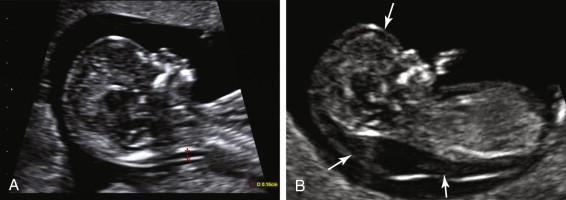
The NT measurement is obtained perpendicular to the long axis of the fetus using calipers with a “+” configuration (not other characters such as “x”). The horizontal component of the caliper should be positioned along the inner margin of the lines bordering the NT, not extending into it ( Fig. 22-2A ). The widest component of the NT is measured. The image should be obtained in a midline sagittal plane in which the fetal head, neck, and upper thorax occupy at least 75% of the field of view (see Fig. 22-2B ). Scanning parameters should be optimized for image clarity and the margins of the echogenic lines defining the nuchal space should be well-defined. The fetal neck should be in neutral position, without flexion or hyperextension. It is important to identify the amnion separate from the skin line bordering the NT to avoid a spuriously enlarged measurement due to mistaking the amnion for the fetal skin (see Fig. 22-2C ). The NT measurement is valid when the crown-rump length of the embryo is between 45 and 84 mm (precise crown-rump length parameters are laboratory specific and vary slightly from these limits depending on the laboratory), which corresponds to approximately 11 to 14 weeks. The maximum measurement that meets the aforementioned criteria should be reported, not the average measurement.
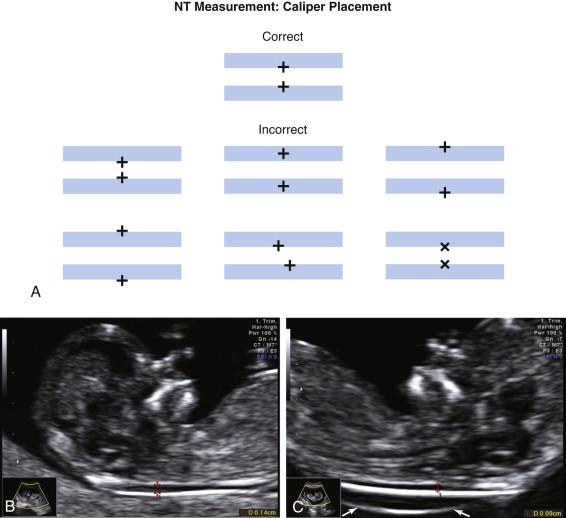
NT should not be used by itself to assess the likelihood of aneuploidy. The accuracy of NT for predicting aneuploidy is greatly improved when combined with other parameters such as maternal age and first-trimester maternal serum biochemical markers (also called serum analytes ) to calculate a projected risk of aneuploidy. The first-trimester biochemical markers currently used are beta-human chorionic gonadotropin (β-hCG; either free or intact depending on the laboratory) and pregnancy-associated plasma protein A (PAPP-A). Levels of these markers tend to be different in aneuploid pregnancies when compared with euploid pregnancies. For example, the typical pattern in trisomy 21 is high β-hCG and low PAPP-A levels. In trisomies 13 and 18, both β-hCG and PAPP-A levels are typically low ( Table 22-1 ). Additional schemes combining first- and second-trimester findings in various combinations (e.g., contingency, integrated, and stepwise sequential screening) are also offered by some practices.
| Markers | Increased Risk of |
|---|---|
| High β-hCG and low PAPP-A | Trisomy 21 |
| Low β-hCG and low PAPP-A | Trisomy 13 and trisomy 18 |
| Low PAPP-A (less than fifth percentile) | Increased risk of pregnancy complications |
When the NT is obviously thick, measuring 3 mm or more, the likelihood of an abnormal screen result is sufficiently high that additional testing such as chorionic villus sampling is frequently offered without waiting for the results of biochemical screening ( Fig. 22-3 ). The ultrasound appearance of a thick NT overlaps that of a cystic hygroma, both of which are associated with an increased risk of aneuploidy. The term cystic hygroma is used when the thick NT is septated ( Fig. 22-4 ). A thick NT in a fetus with a normal karyotype is associated with an increased incidence of structural anomalies and syndromes ( Fig. 22-5 ). Because cardiac anomalies are most common, fetal echocardiography is frequently offered in the setting of a thick NT and normal karyotype. Low PAPP-A level (less than the fifth percentile) is associated with an increased risk of pregnancy complications (e.g., fetal growth restriction, preeclampsia, preterm delivery, and miscarriage) and is often considered an indication for a growth scan.
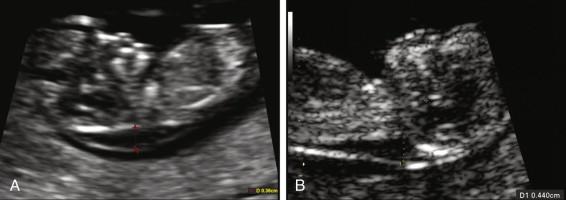
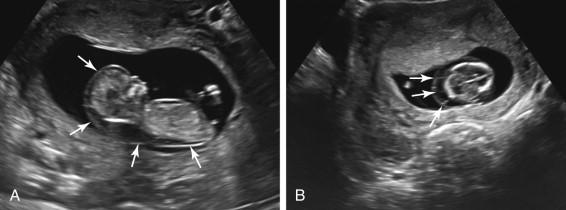
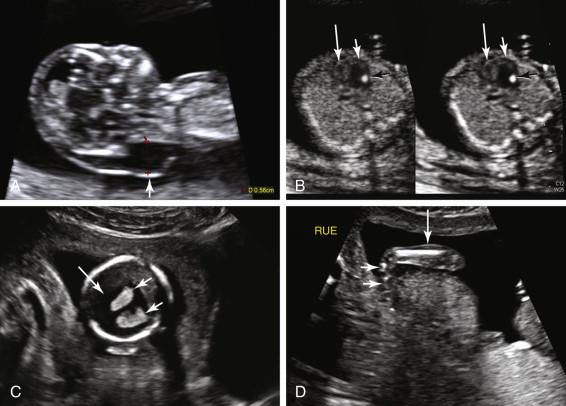
Assessment of the presence or absence of nasal bone ossification can improve the accuracy of first-trimester screening. Nasal bone assessment during the first trimester is operator and experience dependent, and is generally considered an adjunct to NT, rather than a primary screening method. The nasal bone should be imaged on a midline profile view of the embryo that also demonstrates the overlying skin surface. The nasal bone is depicted as an echogenic line immediately deep and parallel to the linear echo from the skin surface ( Fig. 22-6A ). The tip of the nose is also frequently visualized as an additional echogenic focus slightly anterior and caudal to the echogenic skin line. Nonvisualization of the nasal bone is associated with an increased risk of trisomies 21, 18, and 13 (see Fig. 22-6B ).
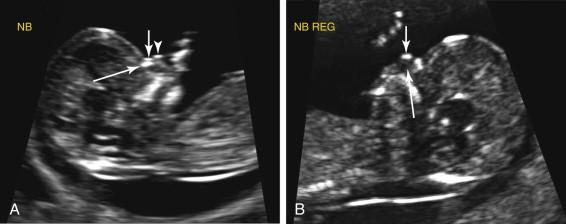
Maternal serum screening for aneuploidy during the second trimester utilizes a different complement of biochemical markers than first-trimester screening. The quad screen (also termed tetra screen ) includes assessment of alpha-fetoprotein (AFP), hCG, unconjugated estriol (uE3), and inhibin-A, and is typically performed between 15 and 21 weeks of gestation ( Table 22-2 ). In pregnancies with trisomy 21, AFP and uE3 levels tend to be low, whereas hCG and inhibin-A levels are high. In trisomy 18 AFP, uE3, and hCG levels are decreased and there is no significant change in inhibin-A level. The screens are also helpful in identifying fetuses at increased risk of open neural tube defects and body wall defects, both of which are associated with high levels of AFP. When elevated levels of AFP or hCG are unexplained by a structural abnormality, there is an increased likelihood of pregnancy complications such as growth restriction, preeclampsia, preterm delivery, and stillbirth.
| Markers | Increased Risk of |
|---|---|
| Low AFP and uE3, high hCG and inhibin-A | Trisomy 21 |
| Low AFP, uE3, and hCG | Trisomy 18 |
| High AFP | Neural tube defect, body wall defect |
| Unexplained high AFP or unexplained high hCG | Increased risk of pregnancy complications |
Soft markers are ultrasound findings that increase the risk of aneuploidy, but are associated with a normal outcome in the majority of fetuses. In the absence of aneuploidy or other abnormalities, soft markers do not cause adverse sequelae. Major structural abnormalities, also seen in fetuses with aneuploidy, differ from soft markers in that they are often associated with an adverse outcome. When major structural anomalies are visualized, management decisions are likely to be primarily dictated by the structural anomalies rather than the presence of soft markers.
Nuchal fold describes the soft tissue along the back of the lower fetal head, just above the neck. It is measured from the posterior margin of the occiput to the outer skin surface on an axial image of the head ( Fig. 22-7A ). The measurement is valid from 15 to 20 weeks of gestation and is generally considered too thick if it is 6 mm or larger, although some practices use a slightly lower threshold of 5 mm. Despite the similarity in name, the nuchal fold differs from the nuchal translucency (NT), which is measured earlier in pregnancy between approximately 11 and 14 weeks of gestation in a midsagittal scan plane, whereas the nuchal fold is measured between 15 and 20 weeks in an axial scan plane. If the scan plane for measuring the nuchal fold is angled too steeply, a spuriously thickened measurement may be obtained. To prevent this, the image should optimally be obtained in a plane that includes the cavum septi pellucidi, thalami, cerebellar hemispheres, cisterna magna, and occipital bone (see Fig. 22-7B ). Falsely thickened values can also be related to fetal position as larger measurements are commonly seen in fetuses in breech presentation as well as when the neck is extended.
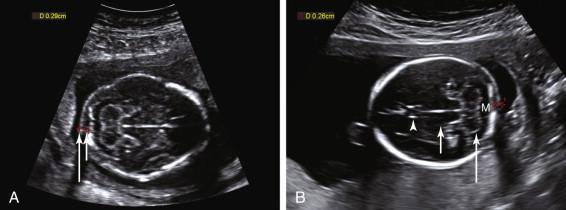
Nuchal fold thickening is associated with a high risk of Down syndrome ( Fig. 22-8 ). It also occurs in other aneuploidies such as Turner syndrome, trisomy 13, and trisomy 18. Nuchal fold thickening is a sufficiently compelling marker that karyotyping is usually offered even when it is an isolated finding. Until recently nuchal fold thickening was considered the single most sensitive and specific second-trimester ultrasound marker for Down syndrome. More recently, nonvisualized nasal bone (see “ Nonvisualized Nasal Bone ” section that follows) has been shown to be a promising second-trimester marker and may prove to be similar in significance to the nuchal fold.
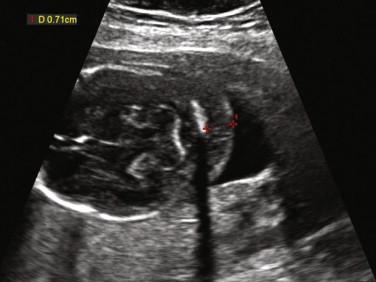
Ultrasound depicts the nasal bone as an echogenic linear structure parallel and deep to the skin surface in the region of the nose ( Fig. 22-9A ). A small nose with a flattened nasal bridge is a feature of Down syndrome facies. Absence of nasal bone visualization during the second trimester has been shown to be a promising marker for trisomy 21 (see Fig. 22-9B ). Nonvisualization of the nasal bone is a much stronger marker for Down syndrome in the second trimester than in the first trimester. Failure to visualize the nasal bone in the second trimester occurs in approximately 1% of normal fetuses and 30% to 40% of fetuses with trisomy 21.
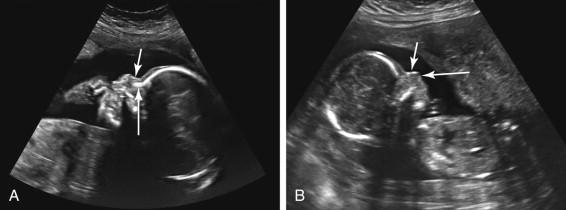
Become a Clinical Tree membership for Full access and enjoy Unlimited articles
If you are a member. Log in here